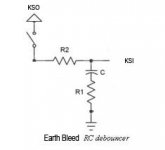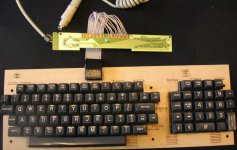RickNel
Veteran Member
For a project, I've re-wired the switch matrix of a vintage mechanical keyboard (from a serial terminal) to match the switch matrix of an AT keyboard, based on the Intel 83C51KB controller. According to the Intel datasheet, the controller chip has internal debounce circuitry, so I followed the original membrane matrix pin for pin, 8 KSO x 16 KSI, leaving out redundant switch points and re-mapped to the key combinations.
When connected to a PC, most keys are read correctly but about 25 keys produce either two characters or an unrecognised code. The character pairs are always the correct (re-mapped) character plus another character that shares one of the same address lines, either KSO or KSI. They are never adjacent characters in the matrix, but separated by four or five lines. There are no shorts or dry joints within the matrix.
One thing I have noticed is that the original printed membrane circuits exhibit a small resistance factor between switch and connector, from 3ohms up to 12ohms for the longest traces. My re-wired mechanical matrix uses transformer winding wire and resistance never measures above 1.5ohms, usually .8ohms. I'm wondering whether that higher resistance in the membrane circuit might have functioned to stabilise the scanning signals as some sort of pull-up.
I've also noticed that the membrane circuit has a little 1cm extension twig at the far end of each printed matrix line, which doesn't connect to anything. I'm wondering if those twigs create some sort of terminating capacitance to the earth mat printed under the bottom membrane.
Advice sought how to condition the keyboard signals appropriately, or any other causes for the controller misreading key switches.
Rick
When connected to a PC, most keys are read correctly but about 25 keys produce either two characters or an unrecognised code. The character pairs are always the correct (re-mapped) character plus another character that shares one of the same address lines, either KSO or KSI. They are never adjacent characters in the matrix, but separated by four or five lines. There are no shorts or dry joints within the matrix.
One thing I have noticed is that the original printed membrane circuits exhibit a small resistance factor between switch and connector, from 3ohms up to 12ohms for the longest traces. My re-wired mechanical matrix uses transformer winding wire and resistance never measures above 1.5ohms, usually .8ohms. I'm wondering whether that higher resistance in the membrane circuit might have functioned to stabilise the scanning signals as some sort of pull-up.
I've also noticed that the membrane circuit has a little 1cm extension twig at the far end of each printed matrix line, which doesn't connect to anything. I'm wondering if those twigs create some sort of terminating capacitance to the earth mat printed under the bottom membrane.
Advice sought how to condition the keyboard signals appropriately, or any other causes for the controller misreading key switches.
Rick





